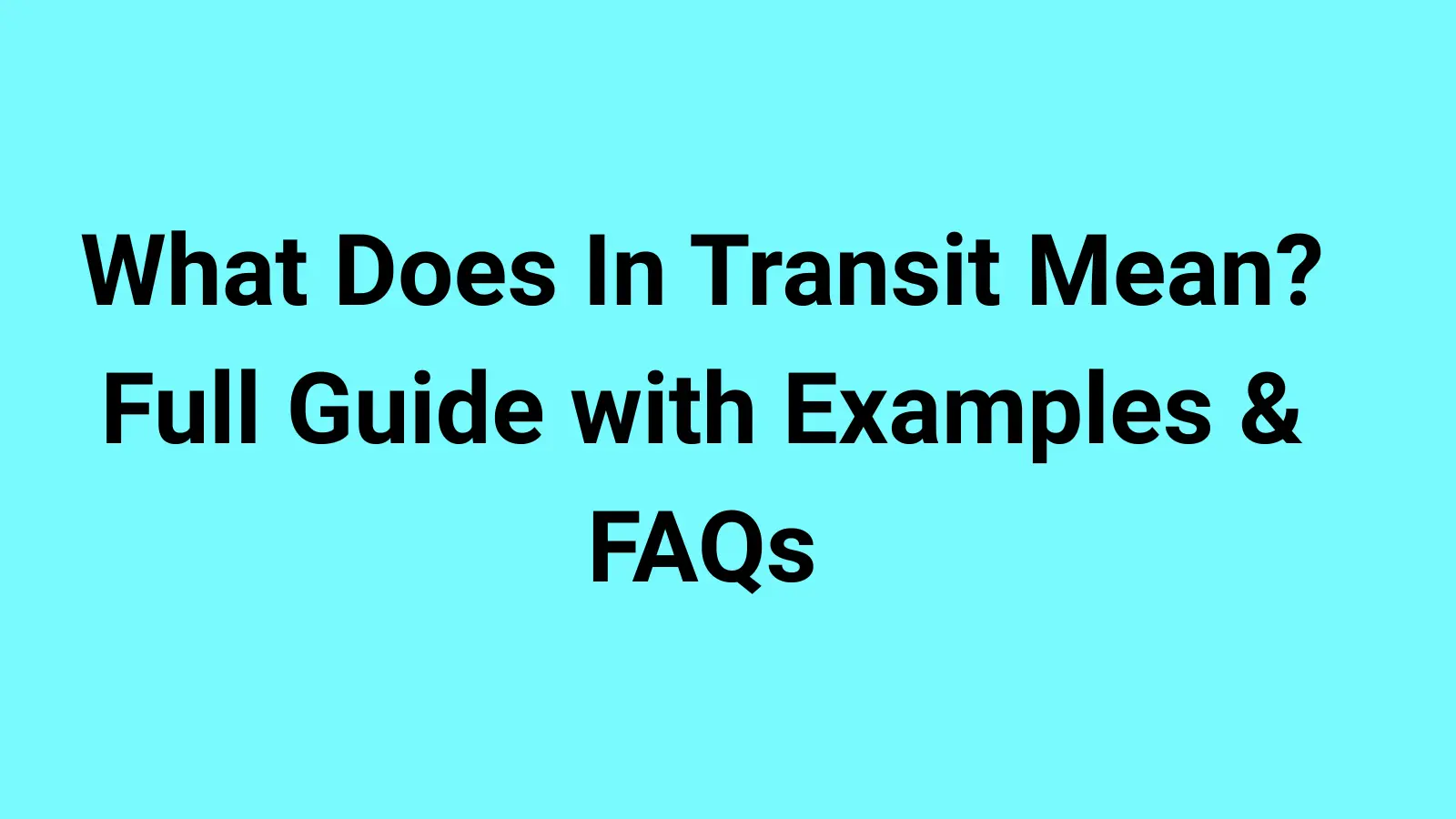If you’ve ever tracked an online order and seen the status “in transit,” you may have wondered: what does in transit mean? In simple terms, in transit means that your package, shipment, or delivery is on its way from the sender to the recipient.
It has been shipped out, is moving through the logistics network, and is not sitting idle. This phrase is used in shipping, freight, courier services, and even banking, and while the meaning stays similar, the context can change.
In this complete guide, we’ll break down everything you need to know about the meaning of in transit covering definitions, real-life uses, shipping examples, common FAQs, and tips to understand your tracking updates better.
📌 What Does In Transit Mean in Shipping?
The most common place you’ll see in transit is when tracking a delivery.
- 📦 It means your package is on the move through the carrier’s network.
- 🚛 The item has left one facility and is en route to the next.
- 🛑 “In transit” doesn’t mean stuck—it just hasn’t reached its next checkpoint.
- ✈️ Could be traveling by truck, plane, or ship depending on the route.
- ⏱ Often appears after “Shipped” and before “Out for Delivery.”
- 🔄 Status may show for several days depending on distance.
- 🛣 May involve multiple stops before reaching your city.
- 🕒 Doesn’t mean it’s late—just still moving.
- 📍 No exact GPS, just carrier updates.
- 🌍 Used globally by USPS, FedEx, DHL, UPS, and more.
- 🛃 International packages may show “in transit” while clearing customs.
- 🔍 Context matters—some carriers add details like “in transit to next facility.”
- 😌 Generally a good sign: your order is not delayed, just traveling.
- ✅ In short: It’s moving, not waiting.
📌 What Does In Transit Mean for Couriers Like FedEx, UPS, DHL?
Each courier defines in transit in a slightly different way.
- 🚚 FedEx – Package is moving within their network, not yet delivered.
- 📦 UPS – Shipment is traveling toward destination, may pass through hubs.
- ✈️ DHL – Often covers international moves, includes customs processing.
- 📮 USPS – Package is traveling between facilities, not yet out for delivery.
- 🌍 Global couriers use “in transit” universally for tracking.
- ⏱ Can last hours, days, or weeks depending on distance.
- 🛫 Air freight shows longer “in transit” status across countries.
- 🛃 Customs clearance may still fall under “in transit.”
- 📍 May not show every single city stop.
- 🔄 Status refreshes only when scanned at checkpoints.
- 🕒 Patience required—sometimes updates lag behind.
- ❌ Doesn’t mean “lost,” just “in progress.”
- 😅 Many people panic at long in-transit updates, but it’s normal.
- ✅ Always check the estimated delivery window alongside status.
📌 What Does In Transit Mean in Banking?
Outside shipping, banks also use the term in transit.
- 💰 Refers to money transfers not yet cleared.
- 🏦 Deposits may be “in transit” before reaching your account.
- 💳 Credit card payments may show “in transit” before posting.
- 💵 Cash sent between branches may be listed as “in transit.”
- 🔄 Same principle: funds are moving but not yet settled.
- ⏱ Can take hours to days depending on the bank.
- 🌍 International transfers often marked “in transit” longer.
- 📑 Appears in reconciliation documents for businesses.
- 🧾 Accounting term: cash in transit = funds sent but not recorded.
- ✅ Assurance: money isn’t missing, just processing.
- 📲 Online banking apps often display “in transit” for pending transfers.
- 🛠 Businesses track “goods in transit” as part of inventory.
- 🔐 Safe transfer system ensures funds are secure.
- 📉 Temporary status, soon updated to “completed.”
📌 What Does In Transit Mean in Logistics?
In logistics, the meaning expands to cover supply chains.
- 🚛 Goods moving between warehouses.
- 🛳 International shipments at sea or air cargo.
- 📦 Pallets and containers often marked “in transit.”
- 🏭 Movement from factory to distribution center.
- 🛒 E-commerce relies heavily on in-transit tracking.
- 📊 Businesses calculate “inventory in transit” for supply planning.
- 🕒 Longer distances = longer in transit periods.
- 🌍 Cross-border shipping always involves in-transit phases.
- 📍 Some logistics systems provide GPS for in-transit goods.
- 🏢 Third-party logistics providers (3PL) report in-transit updates.
- 🔄 Delays (weather, strikes, customs) still show as “in transit.”
- 🚦 Transit hubs act as checkpoints.
- 🤝 Buyers and sellers track in-transit status to manage expectations.
- ✅ In short: It’s about movement in the chain, not final delivery.
📌 What Does In Transit Mean for International Shipping?
If you’ve ever ordered overseas, you know this one.
- 🌎 In transit may last days or weeks.
- 🛃 Customs checks fall under “in transit.”
- 🛫 Package may travel across multiple countries.
- 🚛 Trucks + ships + planes all included.
- 🕒 Time varies depending on shipping method (express vs economy).
- 📍 Tracking may only show origin and destination.
- 🛠 Carriers sometimes outsource, still marked “in transit.”
- 💸 Cheaper shipping = longer in-transit time.
- ⏱ Patience required for international orders.
- 📦 Parcel consolidation hubs extend transit stages.
- 🔄 Updates may not appear daily.
- ❓ “In transit” may confuse buyers, but it’s standard.
- 🤝 Sellers reassure customers that “in transit” is progress.
- ✅ Always check estimated delivery time.
📌 Real-Life Examples of “In Transit” Status
Here are common scenarios:
- Online order:
- Status: “In transit to next facility.”
- Meaning: It’s moving between warehouses.
- International package:
- Status: “In transit, arriving late.”
- Meaning: It’s delayed but still on the way.
- Bank transfer:
- Status: “Funds in transit.”
- Meaning: Payment sent but not yet cleared.
- Logistics report:
- Status: “Inventory in transit.”
- Meaning: Goods shipped but not received.
- Courier app:
- Status: “Your item is currently in transit.”
- Meaning: It’s traveling in the delivery chain.
📌 Common Misconceptions About In Transit
Many people misunderstand this status.
- ❌ Thinking it means “stuck.”
- ❌ Believing the package is lost.
- ❌ Expecting constant location updates.
- ❌ Assuming delivery will happen immediately.
- ❌ Confusing “in transit” with “out for delivery.”
- ❌ Believing banking “in transit” means error.
- ❌ Ignoring time zones in international transit.
- ❌ Thinking no update = no movement.
- ❌ Assuming tracking works like GPS.
- ❌ Overthinking wording differences between carriers.
- ❌ Forgetting weekends/holidays affect updates.
- ❌ Expecting daily scans.
- ❌ Assuming “delayed in transit” means canceled.
- ❌ Forgetting transit is a normal part of shipping.
📌 How Long Does In Transit Last?
The big question: how long is normal?
- 🚚 Domestic shipping: 1–5 days average.
- ✈️ Express international: 3–7 days.
- 🚢 Economy international: 2–6 weeks.
- 🛃 Customs delays: add days or weeks.
- 📦 Rural deliveries: longer transit times.
- 🏢 Business shipments: tracked more tightly.
- 📲 Courier apps provide rough estimates.
- 🕒 Banking transfers: hours to 5 business days.
- 📉 Inventory in transit: days to months.
- ⏱ Depends on carrier and distance.
- 🔄 Tracking updates don’t always sync in real time.
- 😅 Patience is key—longer doesn’t mean lost.
- ✅ Always check estimated delivery window.
- 🌍 International = longest transit phases.
📌 Difference Between “In Transit” and “Out for Delivery”
These two statuses confuse people the most.
- 🚛 In Transit = Package is moving, not yet at your local facility.
- 📍 May be anywhere along the route.
- 🕒 Could last days.
- 📦 Out for Delivery = Package is at local hub and on the truck to your address.
- ⏱ Usually delivered the same day.
- 🔍 In transit = journey. Out for delivery = final step.
- ✅ Easy way to tell: If it says “out for delivery,” expect it soon.
📌 Why Do Packages Stay In Transit So Long?
Sometimes “in transit” feels endless. Here’s why:
- 🛃 Customs checks.
- 🛫 Flights rescheduled.
- 🚢 Sea freight takes weeks.
- 🚚 Ground delays (traffic, weather).
- 📦 Consolidation at hubs.
- 🏭 Sorting backlogs.
- 📍 Limited scan points.
- 🕒 Time zone differences.
- 🛑 Holidays/weekends slow progress.
- 🔄 Transfer between carriers.
- 📉 Rural or remote area deliveries.
- 🛠 Technical glitches in scanning.
- 🌍 Distance covered.
- ✅ All normal parts of global shipping.
📌 Tips for Tracking In Transit Packages
Here’s how to make the wait easier.
- 📲 Use carrier’s official app.
- ⏱ Check estimated delivery dates.
- 🌍 Consider time zone differences.
- 📦 Sign up for text/email alerts.
- 🔄 Track with order number, not just name.
- 🛃 Expect longer waits for international.
- 🛑 Don’t panic at “in transit” for days.
- ✅ Contact carrier only if past delivery window.
- 🕒 Keep patience—tracking isn’t real-time GPS.
- 📍 Use third-party trackers for more detail.
- 📑 Keep receipts and order confirmation handy.
- 💬 Contact seller if needed.
- 🛠 Track both carrier and marketplace system.
- 🎉 Relax—most packages arrive safely.
📌 FAQs on What Does In Transit Mean
Q1: Does “in transit” mean my package is lost?
👉 No, it simply means it’s moving through the delivery network.
Q2: How long can a package stay in transit?
👉 Hours to weeks depending on distance and shipping method.
Q3: Is “in transit” the same as “out for delivery”?
👉 No, out for delivery means it’s arriving that day.
Q4: Why hasn’t my package updated from in transit?
👉 Scans only happen at checkpoints; movement still continues.
Q5: What does “in transit” mean in banking?
👉 It means funds have been sent but not yet cleared.
Q6: Can customs hold a package during in transit?
👉 Yes, customs delays are common.
Q7: Should I worry if in transit takes long?
👉 Not usually—delays are normal, especially international.
Q8: Does in transit mean on a truck?
👉 Sometimes, but it could also be on a plane or ship.
Q9: Can I speed up in transit shipments?
👉 Not once shipped, but express methods reduce future wait times.
Q10: Why does banking “in transit” show for days?
👉 Transfers, weekends, and clearing systems cause delays.
📌 Final Thoughts on What Does In Transit Mean
The phrase “in transit” simply means that something—whether a package, goods, or money—is on its way. In shipping, it’s the journey between origin and destination.
In banking, it’s the stage where funds are moving but not yet posted. While the term may feel vague, it’s actually reassuring: it means progress is happening.
Next time you see “in transit,” you can relax knowing it’s just part of the journey, not a sign of trouble.



